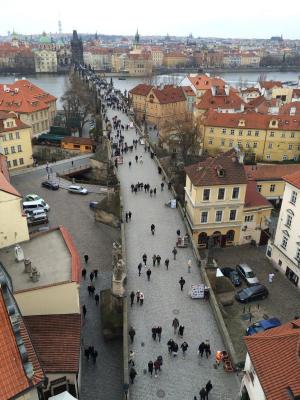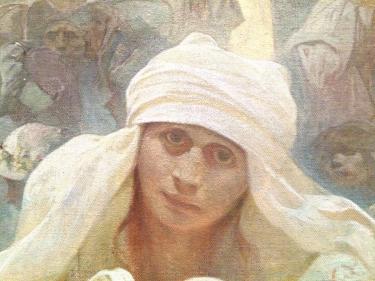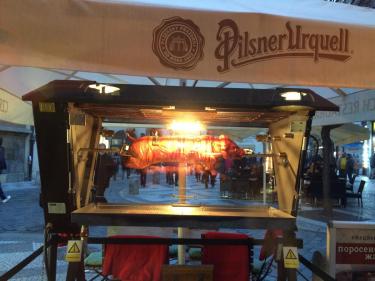We spent 3 weeks in Prague. Other than our 3 weeks in Montenegro, it was the longest we’ve stayed put this 7-month stint in Europe. This was partly because we’ve heard such great things about Prague and partly because we figured it good timing for a longer stay as we wound down our foray into Central Europe and began to make our way back to “The West”.
The problem with having heard such great things about a place is the high expectations that develop. But Prague delivers on those high expectations. For travelers to Europe who are considering “plunging a bit further”, Prague is a great place to start or to home base. It’s a beautiful medieval city, a blend of Bavarian architecture, Bohemian culture, central European (meaning hearty, stick-to-the-bones) cuisine, and a well-deserved reputation for great beer. Add to that reasonable costs (especially during off season) and it’s a great destination on par with cities like Paris, London, and Rome.
Much of the best-to-see in Prague is the city itself. Go wandering in the Old Town or the Hradčany neighborhood on the west side of the River Vltava. After a couple of hours stop for a lunch and a beer. But for the agenda-setting travelers, here are our suggestions on what to put on your to-do list.

Charles Bridge and Tower – This pedestrian bridge spanning the River Vltava is Prague’s Eiffel Tower. The cobblestone bridge features a couple of dozen statues, craft vendors, artists, and busking musicians as diverse as 40’s big band swing and classical violinists (“fiddlers” for our Southern readers). Even if you’re only staying in Prague for a few days, you should walk the Charles Bridge a few times: early morning, mid-day, and at twilight. Be sure to climb one of the two towers at either end of the bridge: if both are open and you have a choice, climb the east tower in the mornings or the west tower late afternoons so the sun isn’t in your eyes when facing the bridge.

Staromēstské Námēsti and Rathaus Tower – This is Prague’s main Old Town square and hub of activities. It’s flanked by a couple of don’t-miss churches (the more interesting baroque-styled St. Nicholas and the commanding but dark Our Lady Before Tyn), statues and monuments and fancy buildings. A centerpiece is the Astronomical Clock, which is easy to find just by looking for the crowd of people looking up (especially just before the top of the hour). It is the Crown Jewels for mechanical clock lovers. Standing in front of the clock you won’t be able to miss the tower and the people staring down at you. You’ll want to climb that tower both for the views of the city and the interesting museum (mostly about World War II’s impact to Prague) on the climb up. If you’re really lucky, the square will be the site of a fair (Prague’s weeks-long Easter fair began just as our visit was winding down). If you’re a Rick Steves fan, his Prague Old Town Walk is well worth the effort and starts in this square.

Spanish Synagogue – A few blocks off the square is the Spanish Synagogue. While the architecture and history of the building itself is of interest and worthy of a couple of hours, of particular interest is the museum of silver items in the synagogue. It’s really just a small room off the synagogue’s upper floor (don’t miss it thinking you’ve seen everything), but it’s jam-packed with beautiful examples of Central Europe’s finest silver smiths, particularly items used in Jewish worship. Included with your ticket is access to another museum around the corner, worth your visit only if you have a bit of extra time.
Prague Castle and St. Vitus Cathedral – On the west side of the river is a hill running roughly parallel to the river, and along that hill’s crest are this pair of sites to see. No doubt before you get here you’ll snap plenty of pictures of these buildings as they offer great pictures from the opposite side of the river and the Charles Bridge. Indeed, the best pictures you’re likely to get of the castle and cathedral will be from a distance, but if you have time they’re worth a visit. If you’re short on time, just walk the hilly, twisty, narrow streets around them. If you’re enjoying Prague’s beer, head south along the hill’s ridge to the Strahov Monastery and their brewery for some great beer and Czech food (lots of tasty, succulent pork).

Slav Epic – Czech artist Alfons Mucha is best known for his contributions to the Art Nouveau movement, but as an ardent Czech Nationalist he wanted to capture the history of the Czech slavs in a special collection of large format paintings. Now we don’t have any particular connection–ethnically, culturally, politically, or any other -lly–to the slavic peoples of Central Europe, but we were wonderfully impressed with Mucha’s Slav Epic (as he titled the entire collection). It is a set of 20 large (and we do mean large) paintings of various historical scenes of importance to the slavic people, infused with the Art Nouveau style and modern allegorical elements. Mucha’s ability to capture emotion is much better displayed in Slav Epic than in the work that made him famous. The museum is a bit out of the way and in an uninteresting neighborhood but well worth the effort for art lovers.
Mucha Museum – For Mucha’s better known work, visit this small, more conveniently located museum a few blocks from the main Old Town square. While Mucha produced plenty of art for art’s sake, much of his body of work was of a commercial nature, such as posters advertising theatre performances. He had a special affinity with actress Sarah Bernhardt, who often insisted her play’s posters be painted by Mucha. We visited this museum almost as an after-thought, and we’re glad we did. If you like the Art Nouveau style, you’ll likely be visiting Prague with this museum as your #1 destination in mind. For a deeper look at Mucha, check out this blog written by our son (a bonafide Mucha fan).

Roasted Pig – Ok, well this is not really a must-see per se, but as you wander around Prague you’ll see pigs roasting on a spit. Take our word for it: they’re as good as they smell.






